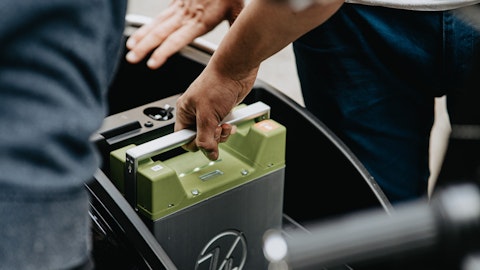Operator: Our next question is from the line of Jerry Revich with Goldman Sachs.
Jerry Revich: Mark, congratulations on the strong quarter here within your first 30 days. I just want to ask the really strong start to the year versus initial expectations driven by better supply chain performance. Obviously, it’s super early in the year but the guidance is unchanged ? Would you characterize that as upside risk to the margin outlook if the supply chain performance continues along this track or are there any factors maybe within F&E that are that are holding you back from saying that we’re probably tracking towards the high end of the range at this point?
Mark Skonieczny: Yes, I don’t think I want to see another quarter play out here, Jerry and we’ll commit to a tightening of that range into Q2 like we normally do traditionally. Obviously, last year was anomaly but the previous year. So we’ll tighten the range. I do — as I go out these facilities, I want to get a better sense of what the margin profile and actually execution is going to be and starts and completions more importantly. So, we really do have nice momentum and we were able to see that in commercial on the conversion that they did in the quarter. So I’m encouraged by that as well as the recreation continue to maintain a strong conversion in the products that continue to sell the Bs and Cs. So I really want to wait just another quarter until I get my hands around the whole portfolio here and where we’re going to end up.
Jerry Revich: Fair enough. And then within the RV line of business, how do you think about the baseline level of demand because part of the reason we’re going to have orders in the $100 million per quarter range as you outlined, is because just the backlog is so long. What do you see as the sell-through rate or what do you see as the underlying level of demand as you’re thinking about potentially what that business might look like in ’24?
Mark Skonieczny: Yes, like I said and I think it’s been consistent with what we’ve — and I think the strategy we’ve talked about a getting ahead of our skis here and managing to a trough, especially in our Class A business. So we’ve been pretty successful. There’s no doubt as other people have said, too, that we’re seeing some drop in the demand on the Class A but that really hasn’t been participating in the upturn and our towable exposure is obviously a lot lower than what we see in some of our competitors. So we continue to be on allocation in our high-end Class C business. So that’s another — we still see strong demand in that market. So I would expect it’s really a mix between the categories. But ultimately, we thought these are pretty frothy backlogs and we were looking to get to a more normalized level by the end of the year.
We still think that will happen here in that, like I said in my quoted remarks. So again, demand will see the selling season here. I’ve been able to participate in a couple of the dealer shows. And I think traffic has generally been in line or up but deal conversions have been more of a challenge. So — but we’re still seeing the strength, as you see in our numbers here in the higher-margin products that we sell.
Jerry Revich: Got it. And lastly, can I ask in Fire & Emergency with some changes in the team. Can you just talk about any philosophical changes from a manufacturing footprint standpoint? Can you expand on that point?
Mark Skonieczny: Yes, I don’t think from a manufacturing footprint standpoint, we did announce the — we do have another COE, Center of Excellence for our TDA product which is up in Ephrata which was a press release that we took out. We took the opportunity to do that. So now we have a chassis COE in Charlotte which we talked about previously that came with Spartan and then Ephrata as well with our TDA. So when you look at our total portfolio and our operating footprint it’s really within those individual factories now, how do we make sure that we can optimize what we have to do. And it’s really in the short-term, it’s a balancing of how we’re going to set up the lines to get through some of these WIP units in that sacrifice the starts for the units that we need to continue to build, right?
So it’s how do you look at it from a short-term with the eye of how do you increase throughput from a long-term perspective as well. So that’s really the purpose of a lot of my visits I’ll go and see how we can optimize in the current environment but not hurting our starts and our ability to generate the revenue we need in the future.
Operator: Our next question is from the line of John Joyner with BMO Capital Markets.
John Joyner: So within F&E, I mean, I guess, just kind of somewhat of a multipart question but have you seen any cancellations? And then kind of given the large and growing backlog there, I mean, I guess, what are the risks that some of these bookings, if you haven’t seen them, then what are the risk of some of these bookings maybe start to get canceled? And then has the inability to get units out the door. I mean has that affected any areas of your market share or overall kind of customer satisfaction?
Mark Skonieczny: Yes, no, John, it really hasn’t. We looked at our — so I would characterize — and we’re talking about fire here. But on the fire side, we do have large backlogs. But the quoting activity and bidding activity is pretty normalized here. And when you look at when we’re going in to bid, we’re more or less on top of the big players in the market here. So we’re not losing anything on lead times. Everyone has these extended lead times based on the current market. From a cancellation perspective, we just haven’t experienced that in the past. We’re dealing with, as you know, a majority of these are municipalities that have a bunch to carry cycle . And as we called in my prepared remarks, we still continue to see high levels of deposits.
So municipalities have the money. They want their units and that’s really my focus. I didn’t mention in my prepared remarks but I did have an opportunity to meet with several of our dealers within the quarter to not just our facilities. And everyone is just asking when they’re going to get their units and that’s really our focus here is how quickly we can get the units out. And so, I don’t think it’s impacting our market share and the bidding is pretty consistent with what we’ve seen in the past. And so there’s definitely nothing that I would say that we’re not within the market from a lead time perspective on what we’re seeing.
John Joyner: Great. And then and maybe this is — I don’t know an understatement but there’s been certainly a lot of transitions of group presidents and other leadership over the past few years. But — so I guess how do you view the current bench? And are there any other openings that still need to get filled?
Mark Skonieczny: No, not currently that’s again as we’ve talked about before, we have changed several general managers and that’s one of my focus here as I visit these plants is meeting with those general managers, I think we have a very strong bench when you talk about local execution. They’re bringing back Mark and Randy I think that was very well received from the channel with Mark’s experience he is been in the industry even after leaving REV the first time. So we’ve gotten great remarks there from a channel perspective and then with Randy’s operational excellence and driving the COO role. So I think from that perspective, I feel real good about what I’ve seen so far in my business. And obviously, I was a CFO previously, so I’ve been part of these, interview process. So I think the bench is very strong at the local level where the execution has to happen.
John Joyner: Great, okay. Maybe just on that kind of similar topic, if I may after implementing furloughs last year, particularly in the Ambulance division, I guess, where are your staffing levels stand today? I mean, are you adequately at levels that you need or are you kind of still carrying more labor than you would need?
Mark Skonieczny: No and so that is from a — and that was more tied to the ambulance where we had furlough because we didn’t have chassis last year. We are in the ramp-up phase and we’ve been very encouraged by the recent hiring event as we start to ramp up. Remember, we had said in the previous quarter, we weren’t going to add more labor back until we had better visibility of chassis and we now have that with most of the plants having visibility through Q3 with the current chassis on hand. So they’ve been hiring at the end of the Q1 and we’ve been getting some very qualified candidates. So, we are seeing a loosening of the labor market a little bit here. So, I would say that based on our current ramp rates, we have the people necessary to deliver on the units we have. We do have built-in ramps in the back and we’re continuing to work on programs to bring on more labor effectively here.



